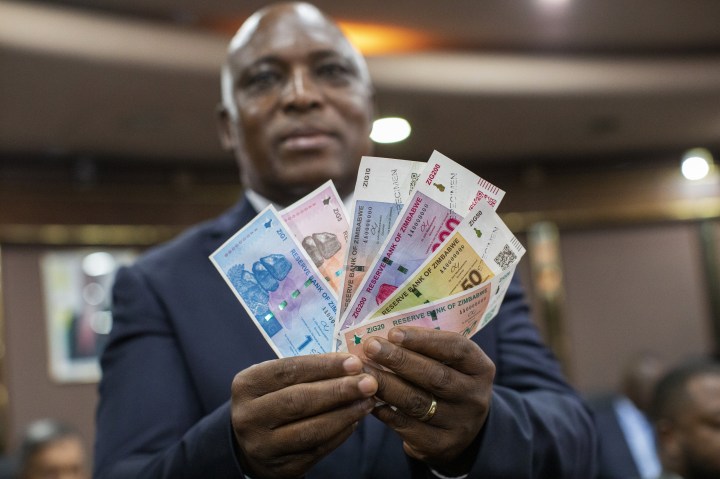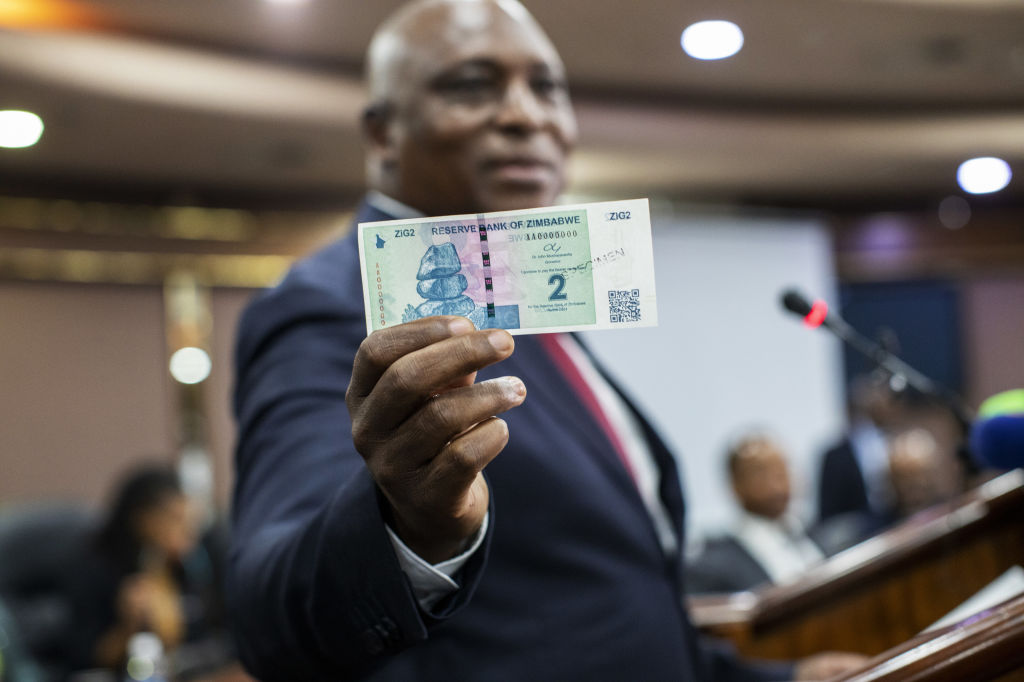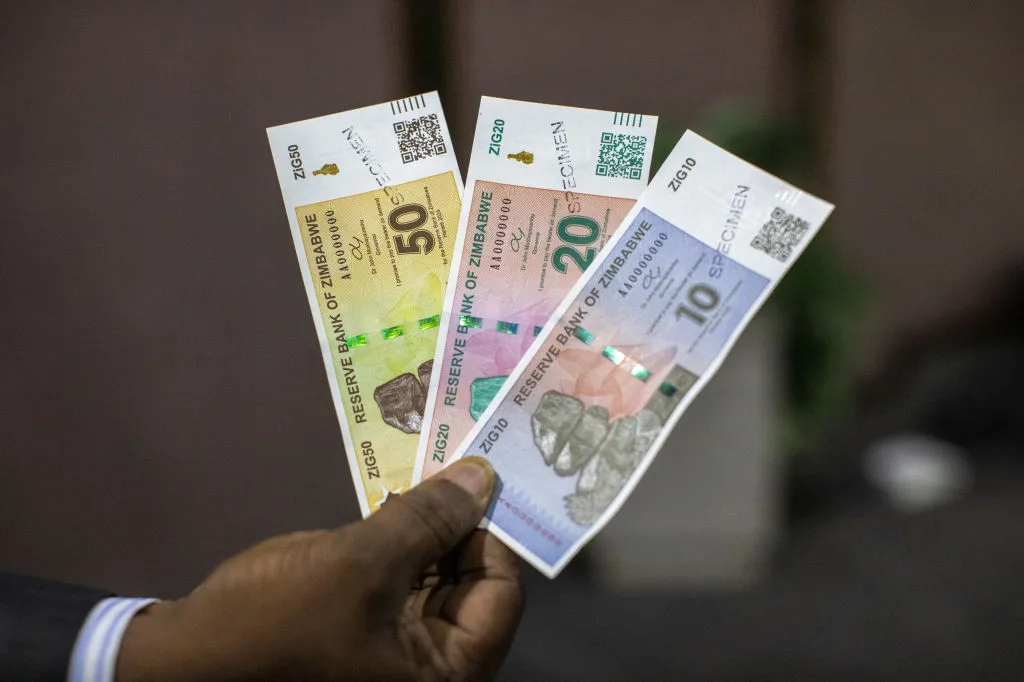BUSINESS ANALYSIS
Loaded for Bear: Zimbabwe failed state has adopted gold standard, what could go wrong?

Take a failed mafia state, a gangster economy and roaring inflation, and attempt to address its obvious shortcomings with a gold-backed currency. The end result will probably look a lot like fool’s gold.
Zimbabwe is effectively a laundromat for illicit gold smuggling, so it seems appropriate that its gangster state has adopted a version of the gold standard to shore up its imploding currency.
Zimbabwe gold — called the ZiG — was officially launched on Monday 8 April. Just over a week after Easter, Zimbabwe is trying to once again resurrect its currency from the dead.
The ZiG is backed by a basket of foreign currencies and gold, which hit new record highs above $2,350 an ounce on Monday, providing a dramatic backdrop to the debut. Other precious metals also comprise part of the basket’s mix.
Read more in Daily Maverick: Zimbabwe Announces New Currency Called the ZiG, Backed by Gold
It is the latest attempt at currency reform by Zimbabwe, a country that has been gripped by economic crisis for decades under the kleptocratic misrule of Zanu-PF.
Harare dumped its currency in 2009 in the face of hyperinflation which saw the central bank’s printing press cranking out 100 trillion Zimbabwe dollar notes — that’s 14 zeros. Golfers would pre-pay for their drinks for the 19th hole because the price could rise tenfold or a hundredfold before they finished their round.
For a decade, Zimbabwe was officially “dollarized” as Harare gave up any pretence that it could manage the economy in such a way that people would actually have faith in its currency. Dollarisation of an economy also breeds criminalisation as Ecuador has discovered, as it provides a haven for money laundering and smuggling.
This helped to enrich Zimbabwe’s corrupt elite. Zanu-PF professes to be anti-imperialist and anti-Western, but its Reds sure love to accumulate greenbacks.
Still, Zimbabwe attempted to relaunch its currency in 2019, and it was a flop. Over 80% of transactions are still conducted in foreign currency, meaning the economy is still effectively dollarised.
The revived Zimbabwe dollar, unable to compete for the affection of the public and investors — not to mention the gangsters in charge — has seen 80% of its value erode so far in 2024, according to Bloomberg. This is again fanning the flames of inflation, which accelerated to 55.3% in March from 47.6% in February, at a time when the staple maize harvest has been devastated by a scorching drought linked to the El Niño weather pattern.
Read more in Daily Maverick: South Africa’s neighbours bear the brunt of dry weather pattern
So lo and behold, the ZiG has been launched in a bid to restore some stability to an unstable economy.
Central Bank Governor John Mushayavanhu said last week that the ZiG would debut at 13.56 per dollar with a new interest rate of 20% compared to the eye-watering level of 130% — the highest central bank rate in the world — which was imposed in a failed attempt to underpin the new currency.
Mushayavanhu, who assumed his unenviable role on 28 March, has pledged not to hit the “print” button on the presses.
“We want a solid and stable national currency in this country. It does not help to print money. Certainly, under my watch it is not going to happen,” he was quoted as saying by Bloomberg.

John Mushayavanhu, governor of Zimbabwe’s central bank with with a new unit called ZiG, which will be backed by a basket of foreign currencies, gold and other precious metals. (Photo: Cynthia R Matonhodze/Bloomberg via Getty Images)
The ZiG will still pointedly not be the only show in town, and will circulate alongside foreign currencies. That, it must be said, is not exactly a ringing vote of confidence.
Companies will be required to pay at least 50% of their taxes in the ZiG — a measure clearly aimed at boosting demand. It also means the Zimbabwean Treasury has to accept the ZiG as part of its trickle of a revenue stream.
The basket to support the currency consists of $100-million in cash and gold reserves that last week were worth $185-million and would fetch a bit more this week. That does not seem like much, but the central banks say that is more than three times the cover needed for the amount of ZiGs to be put in circulation.
Economic turnaround?
But can this basket help to turn around the basket case that is Zimbabwe’s economy?
Well, any attempt at bringing a semblance of sanity to Zimbabwe’s monetary policy is obviously welcome.
If the Zimbabwean public can be convinced to dig the ZiG, it would help to cool inflation and restore some confidence in the central bank and the wider economy.
An International Monetary Fund (IMF) mission to Zimbabwe earlier this year encouraged the country’s policymakers to pursue market reform “… accompanied by establishing an effective framework for exchange rate and monetary policies”.
Whether or not this was what the IMF had in mind, it is a step aimed at bringing stability to the exchange rate and monetary policies.
The IMF also called for far-reaching structural reforms.
“Structural reforms aimed at improving the business climate, strengthening economic governance and reducing corruption vulnerabilities are key for promoting sustained and inclusive growth and would bode well for supporting Zimbabwe’s development objectives,” the Washington-based lender said.

Specimens of the new currency unit called ZiG. (Photo: Cynthia R Matonhodze/Bloomberg via Getty Images)
“Reducing corruption vulnerabilities” is a diplomatic way of saying “clean up your bloody act and bring and stop the looting”.
On Transparency International’s 2023 Corruption Perceptions Index, Zimbabwe got a grade of 24. The scale is 0 (highly corrupt) to 100 (very clean). It ranked 149 out of 180 countries on the index, where the country ranked first is regarded as the least corrupt and last place is perceived as the most corrupt.
This is where the failure of the Zimbabwean state and the resultant economic meltdown really lies.
Zanu-PF is widely regarded to be as corrupt as it is repressive — flip sides of the iron fist of many odious governments. It has been on a looting spree for decades, and is looting the country into the ground.
Read more in Daily Maverick: Once we were liberators, now we are subjugators – Zanu-PF and its history of violence
As South Africans know, when government officials are bent on self-enrichment rather than public service, the delivery of services that underpin the economy collapses.
This gangster state spawns criminal activity on a grand scale, including the smuggling and laundering of illicit gold which is also wrapped up with the illegal trade in cigarettes and tobacco.
Who knows, maybe some of the gold reserves being used to support the ZiG have dubious origins.
The economy has never really recovered from the late former President Robert Mugabe’s disastrous seizure of white-owned farms over two decades ago, with much of the spoils divided among the hyenas of Zanu-PF.
This is Zimbabwe’s sixth attempt since 2008 at establishing a currency that actually works.
But without addressing the broader issues afflicting the economy, this attempt at a currency backed partly by gold looks like it will end in fool’s gold. DM

















 Become an Insider
Become an Insider
Give Zimbabwe a chance. Most of us here in South Africa we wish them well so that things might actually work that side so that most of Zimbabweans living illegally here can go back home.
So some of us wish them well
You are asking about the origin of gold which is backing the Zig,is Zimbabwe not a gold producing country. Why are you not asking the origin of gold backing the US dollar or the British pound.
Because the article is about Zimbabwe, not the USA. Or did you miss that small detail?
Economics 101: Neither the USD nor the BP are backed by gold. They are what are called Fiat currencies. A central bank controls the currency and interest rates. This is the probelm with Zim: there is no confidence in the local currency and they hardly have enough money to print the actual currency on paper. Now they are trying to back the currency with gold but the question is where is the government getting the gold from and how legitimate is it? If the gold is not legit then they are backing a losing wicket as once again business and the public will have no confidence in the currency and will not use it. I would think that Zimbabians will continue to use the USD or conduct their Zim business through outside (SA) banks.
The problem with all this zig thing is that it isn’t going to be compulsory used because in some retails you find out that they will be using usd instead of of the zig